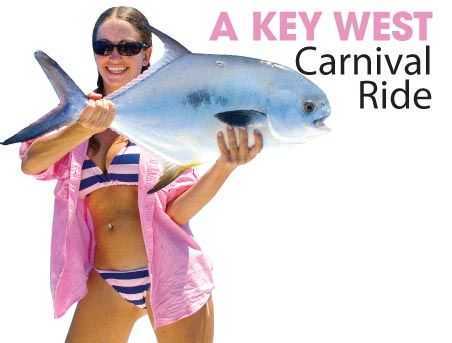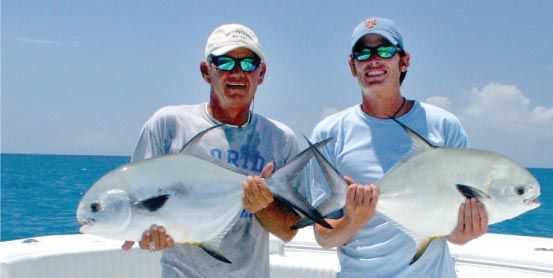“In the spring a young man’s fancy turns to love.”
Schools of spawning permit join the procreational pursuit at a most spectacular of gatherings. In multitudes of silver and gold they mass, holding over a few picturesque spots suspended in crystal waters of the outer bar. Trinity is one such site, a name coined by divers in deference to three coral peaks rising 20-25 feet above a white marl bottom.
Located on the outer reef or bar, this ridge of coral disappeared beneath the waves at the end of the last Ice Age, millennia ago. Running east to west, with an average relief of 10 feet, this outside reef is a phenomenon, occurring nowhere else along the Florida Keys chain. Trinity is a deep spot, 55 feet, and sits inside the Atlantic drop-off due south. Bathed in nutrient rich currents, often by the Gulf Stream itself, the ledges, walls and sea-fan forest of Trinity draw resident fish and traveling schools, layered at times from surface to sea floor. On clear water days the sandy bottom reflects the tropic sun, lighting an outdoor aquarium.
By the second week of April, on rare calm days, spawning permit rise above the corral pinnacles bathing their egg-laden bellies in the warm sun. Often, pinprick fins spike the surface giving up the school. In sun, the mother-permit flashes golden, ripe with the next generation. When flushed, they file beneath the boat matching numbers and moving with the herd mentality of buffalo. Seen from below, they flow over submerged ridges like Hollywood Indians sweeping down on circled wagons.
We’re aboard a powder blue Yellowfin 42 with four high horsepower Mercury’s strapped to the back. Eight minutes out of Key West Harbor, a new Trinity record. Only Popeye’s fried chicken boat made this run faster, and he was on the outward-bound leg of the world powerboat championships.
As one friend Jim Butters put it following a furiously fast ride in the behemoth center console, in less than calm seas, “This isn’t a boat, it’s a carnival ride.”
Captain T.J. Ott is at the wheel. A young man, mid-twenties, T.J. is beyond his years in fish miles. T.J.’s a professional tuna harvester, a skill learned from his dad. Six months of the year he battles thousand pound blue fins with rod and lance. Winter months he’s at the family home in Key West, ranging his ocean rocket west to Dry Tortugas then east to Cay Sal Banks, relentlessly pursuing a tug on the line and fish in the box.
An early morning phone call from Key’s captain Steve Rodgers was short and to the point—permit on the bar. Rodgers, a native son conch captain is privy to inside info, always one of the first to know. We’ll have a day or two before word spreads and boats flock to the site. Secrets don’t last in the southernmost city.
Nikie and I join T.J. and Diesel, a fish hound black Rottweiler weighing in at eighty pounds. Constantly in the shadow of our captain, Diesel stakes out a spot at his master’s feet, daring any challenge. He’s veteran crew and knows where the ride is softest and dry.
The spa-size live well teems in crab. Some, half-dollar size baby blues imported from Miami, others corral colored sand crabs caught this morning by Nikie, wading a shallow bar. All are declawed.
We’ll hook these squiggling crustations thru the pointed end of the carapace on a half-ounce plain lead jig. Thirty pound leader connects the weighted offering to twenty pound braid spooled on Shimano spinners, Flora-carbon of course. Seven-foot Star graphite rods, in tandem with the lead jig provide casting range with backbone enough to muscle a fish. Unlike wreck or tower fishing these permit have no close cut-off place to flee to, a common occurrence around structure. Given enough head they will scrape the hook across the sand bottom or dash under a sharp edge overhang, attempting to rid themselves of the bothersome tug.
There is reason to horse these hard fighting members of the jack family in. Sharks, most often the great American hammerhead, lurk just out of sight. Shadowing the schools these anvil-headed monsters run large, over 10 feet, some eight hundred pounds.
While conjuring a plan for a first drift a shout and splash turns every head. Our informant Steve Rodgers, leading a charter has been fighting a fish since our arrival. Now, the tan tail of a 12-foot shark slaps the side of his Conch 27 while the other end devours his angler’s twenty-pound permit. The fisherman freaks. Not used to seeing a tail the size of a grown man waving at eye level he seems convinced the shark wants him.
With engines at a quite idle, T.J. eases up to a school. We cast our crabs into a group of tiny points directly above a cloud of milling, flashing shapes. Reacting to the splashes, the fish move forward and down. Free-lined off the spools our baits sink with them. Two of the three crabs are eaten. I strike and miss; Nikie’s reel is whining her rod bent double.
The bent rod sends Diesel into frenzy. He covers the length and breadth of the Yellowfin barreling by any unfortunate bystander, barking his excitement, cheering Nikie on. Paws on gunnel, Diesel watches for the fish, if he’s disappointed not seeing a giant tuna it doesn’t show.
Nikie fights this fish like the seasoned pro she is. She holds the spool and lifts the rod smooth, never jerking, and then winds down even and fluid. With skills honed hoisting Halibut in Alaska, this beautiful bartender-angler is a fish-in-the-boat kind of girl.
The action is fast with multiple hook-ups and our luck with the sharks holds through a few close calls. We release nine hard fighting permit, missing a dozen more. Low light brings our slugfest to a halt when wispy clouds gather blocking out the lowering sun. Fueled by cooling air over warmer water these late afternoon formations are common in the spring, the fish disappear with the light.
Another eight-minute ride, then a slow swing by the Mallory Square sunset extravaganza ends the day. We watch “The great Rondine” wiggle in chains. A high wire artist balances on one leg and twirls plates. Cat man directs a pride of felines thru circus routines climaxing with a leap thru a flaming hoop. Nowhere else on earth does this land and sea dichotomy exist. But what to expect when one boards a Key West carnival ride?

